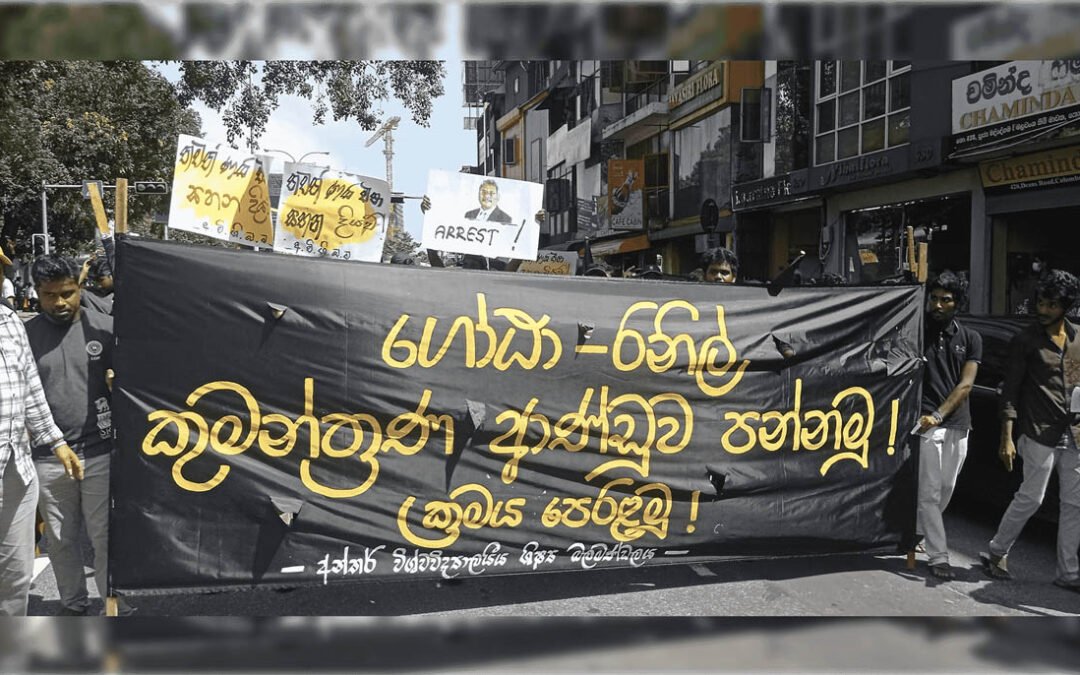Read in : தமிழ்
Politically and economically besieged Sri Lanka could well be staring at another anti-government revolt on the lines of the 71’ and 88’/89’ insurrections, orchestrated by the Marxist and nationalist ‘Peoples Liberation Front’, JVP.
‘Black Monday’ – 9 May – saw one of the most violent and chaotic revolts against the government in Sri Lanka’s recent history, while the police looked the other way. When Rajapaksa loyalists who, without any provocation, turned on the anti-government nonviolent protesters outside the official residence of the Prime Minister – Temple Trees – and at Galle Face Green, few saw the mayhem that would follow.
While the 76-year-old former Prime Minister, Mahinda Rajapaksa and his family were holed up within Temple Trees, furious mobs began bashing on the gates of the residence in a dangerous frenzy. It took the military several hours to come to their rescue, despite a Rajapaksa brother, President Gotabaya Rajapaksa being the Commander-in-Chief of the Armed Forces.
The vengeful rioters then went on to set fire to buses that had transported the Rajapaksa fan base from various parts of the country, to Temple Trees on 9 May. This ‘fan club’ included a group of inmates from a prison camp.
The IUSF became formally active in the mid-70s when the police shot dead a student, Rohana Weerasuriya. Thereafter, student groups loyal to the JVP gained control of the IUSF.
In the subsequent mayhem, a ruling party legislator was beaten to death and his body dragged through the streets. Property, homes and vehicles – including a Lamborghini, two Hummers, a Ferrari, a Cadillac stretch limousine and priceless antique cars – of wealthy Rajapaksa loyalists and ruling party MPs were looted and burnt to cinders.
The rebellious Inter University Students’ Federation (IUSF) – the largest student organisation in Sri Lanka and beneficiaries of the country’s free education system – entering the protest arena is not to be taken lightly. The IUSF became formally active in the mid-70s when the police shot dead a student, Rohana Weerasuriya. Thereafter, student groups loyal to the JVP gained control of the IUSF.
IUSF’s unethical conduct has drawn much criticism by the media and university administrations. The Universities of Colombo and Moratuwa banned the IUSF. Subsequently, the University of Jaffna banned the IUSF from entering its premises.
The IUSF uses strikes as their primary weapon to meet their demands, raising many an eyebrow regarding student discipline.
IUSF has been accused of the murder of a third-year Management student of the University of Sri Jayewardenepura, Samantha Vithanage, for pioneering an anti-ragging campaign in the university.
Rival student groups such as the International Students for Social Equality have accused the IUSF of using ragging as a means of bullying backward students and forcing them on to their side.
At the outset, senior students claimed that ragging served as a social equaliser in the universities. But, with the emergence of JVP-backed student unions such as the IUSF, ragging became the primary method of ensuring the continued domination of JVP political power within the universities.
The IUSF uses strikes as their primary weapon to meet their demands, raising many an eyebrow regarding student discipline. Boycotting lectures has caused endless delays in student graduation time and cancellation of studentships on many an occasion.
Violence within universities has steadily increased due to political intolerance. IUSF has also been accused of engineering clashes between rival political groups in universities and Deans claim that they have been threatened with death for not agreeing with pro-JVP IUSF political ideologies.
Following the signing of the Indo-Sri Lanka accord in 1987, the JVP led by leader Rohana Wijeweera let loose mayhem in the country which almost overpowered the State. Multiple JVP cells operating countrywide, crippled the country, by brutally massacaring the Sinhalese in their thousands, suspected of being against them.
During the 88’–89’ JVP insurrection, Vice Chancellor of the University of Colombo, Stanley Wijesundera came under pressure from the JVP to shut down the university, which he refused. This resulted in him being murdered by a JVPer within the university premises.
Given the above, the involvement of the IUSF in the current anti-government protests doesn’t bode well for Sri Lanka. They have also infiltrated and hijacked the nonviolent ‘Gota Go Home’ village set up at Galle Face Green, from its original nonviolent organisers. As a result, people who thronged the protest site before are now keeping away.
During the 88’–89’ JVP Insurrection, Vice Chancellor of the University of Colombo, Prof. Stanley Wijesundera came under pressure from the JVP to shut down the university, which he refused and it resulted in him being murdered by a JVPer within the university premises.
The JVP under the leadership of Parliamentarian, Anura Kumara Dissanayake and his immediate comrades appeared to have disassociated themselves from the former JVP’s lust for blood. But, the latest wave of violence being attributed by some quarters to the JVP, the majority Sinhalese are beginning to have a sense of déjà vu. Several ruling party members of Parliament who had the homes and vehicles torched are also pointing accusing fingers at the JVP.
If the JVP is found to have instigated the recent wave of crimes, all the hard work they put into cleaning up their blood-thirsty image as an honest and reliable political party will go down the drain. For the majority Sinhalese, the legacy of sheer terror unleashed upon them by the JVP in 88’/89’, will live on.
Read in : தமிழ்











